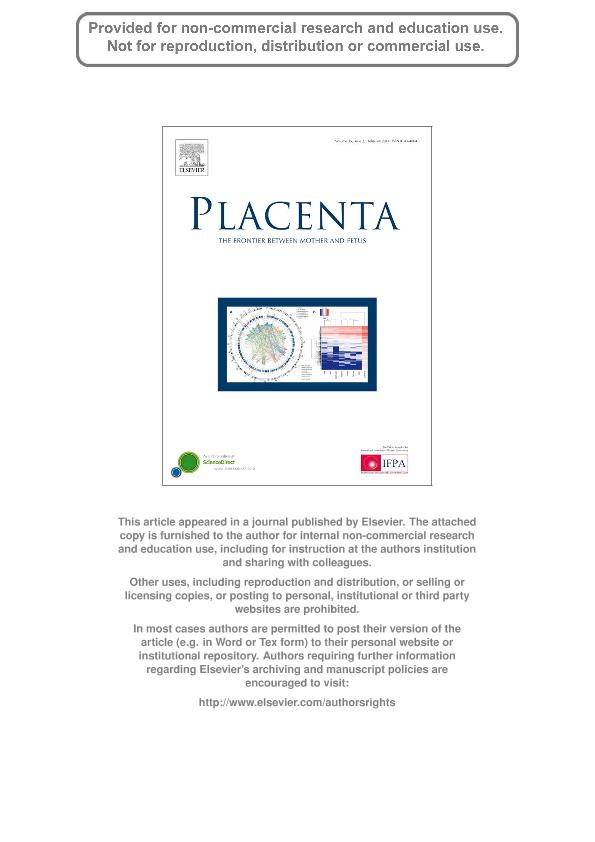Mostrar el registro sencillo del ítem
dc.contributor.author
Marino, Gabriela Inés

dc.contributor.author
Kotsias, Basilio Aristides

dc.date.available
2017-07-13T19:11:21Z
dc.date.issued
2014-02
dc.identifier.citation
Marino, Gabriela Inés; Kotsias, Basilio Aristides; Cystic fibrosis transmembrane regulator (CFTR) in human trophoblast BeWo cells and its relation to cell migration; Elsevier; Placenta; 35; 2; 2-2014; 92-98
dc.identifier.issn
0143-4004
dc.identifier.uri
http://hdl.handle.net/11336/20382
dc.description.abstract
Introduction: ENaC and CFTR are coexpressed in epithelia and have positive or negative functional interactions. In addition, ENaC and CFTR promote migration in placental trophoblastic cells and human airway cells, respectively. Here we tested the idea if CFTR is functionally expressed in BeWo cells, a trophoblastic cell line, and if it is involved in their migratory behavior. Methods: CFTR expression was studied in BeWo cells with RT-PCR, biotinylation and Western blot. Ion currents were analyzed with patch clamp, and cell migration with the wound healing method. Results: The mature CFTR 160-kDa band was present, and its localization at the surface membrane was confirmed. Forskolin (20 μM), an adenylate cyclase activator, was used for channel activation, and subsequently CFTRinh-172 (2 μM) for its inhibition. The conductances in the presence of CFTRinh-172 plus forskolin (16.0 ± 0.7 pS/pF and 32.6 ± 1.5 pS/pF) were significantly lower than in presence of only forskolin (29.7 ± 0.9 and 47.0 ± 2.0 pS/pF). The conductance of CFTRinh-172 inhibited currents was 14.9 ± 0.7 pS/pF with a linear I-V relationship illustrating the nonrectifying properties of the CFTR. Cell migration was measured and covered 11.2 ± 0.4, 24.0 ± 1.7 and 13.9 ± 1.0% of the wound when cells were cultivated under control, forskolin, and forskolin plus CFTRinh-172, respectively. Proliferation was not changed by any of the treatments. Conclusions: Our results shows that BeWo cells functionally express the CFTR which plays a role in the wound healing increasing the cell migration process.
dc.format
application/pdf
dc.language.iso
eng
dc.publisher
Elsevier

dc.rights
info:eu-repo/semantics/openAccess
dc.rights.uri
https://creativecommons.org/licenses/by-nc-sa/2.5/ar/
dc.subject
Cftr
dc.subject
Bewo Cells
dc.subject
Ion Currents
dc.subject
Wound Healing
dc.subject
Forskolin
dc.subject
Cftr Inh-172
dc.subject.classification
Biofísica

dc.subject.classification
Ciencias Biológicas

dc.subject.classification
CIENCIAS NATURALES Y EXACTAS

dc.subject.classification
Bioquímica y Biología Molecular

dc.subject.classification
Medicina Básica

dc.subject.classification
CIENCIAS MÉDICAS Y DE LA SALUD

dc.title
Cystic fibrosis transmembrane regulator (CFTR) in human trophoblast BeWo cells and its relation to cell migration
dc.type
info:eu-repo/semantics/article
dc.type
info:ar-repo/semantics/artículo
dc.type
info:eu-repo/semantics/publishedVersion
dc.date.updated
2017-07-13T17:23:17Z
dc.journal.volume
35
dc.journal.number
2
dc.journal.pagination
92-98
dc.journal.pais
Países Bajos

dc.journal.ciudad
Ámsterdam
dc.description.fil
Fil: Marino, Gabriela Inés. Consejo Nacional de Investigaciones Científicas y Técnicas. Oficina de Coordinación Administrativa Houssay. Instituto de Investigaciones Médicas. Universidad de Buenos Aires. Facultad de Medicina. Instituto de Investigaciones Médicas; Argentina
dc.description.fil
Fil: Kotsias, Basilio Aristides. Consejo Nacional de Investigaciones Científicas y Técnicas. Oficina de Coordinación Administrativa Houssay. Instituto de Investigaciones Médicas. Universidad de Buenos Aires. Facultad de Medicina. Instituto de Investigaciones Médicas; Argentina
dc.journal.title
Placenta

dc.relation.alternativeid
info:eu-repo/semantics/altIdentifier/url/http://www.sciencedirect.com/science/article/pii/S0143400413008631
dc.relation.alternativeid
info:eu-repo/semantics/altIdentifier/doi/http://dx.doi.org/10.1016/j.placenta.2013.12.004
Archivos asociados
